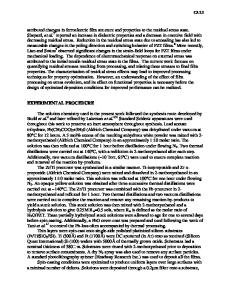Residual stress and microstructure of as-deposited and annealed, sputtered yttria-stabilized zirconia thin films
- PDF / 891,721 Bytes
- 10 Pages / 585 x 783 pts Page_size
- 28 Downloads / 297 Views
Brian Wardle Department of Aeronautics and Astronautics, Massachusetts Institute of Technology, Cambridge, Massachusetts 02139
S. Mark Spearing School of Engineering Sciences, Southampton University, Southampton SO17 1BJ, United Kingdom (Received 10 April 2007; accepted 26 July 2007)
The microstructure and residual stress of sputter-deposited yttria-stabilized zirconia (YSZ) films are presented as a function of thickness (5–1000 nm), deposition pressure (5–100 mTorr), and post-deposition temperature. The as-deposited residual stress of YSZ ranges from −1.4 GPa to 100 MPa with variations in sputtering conditions. Transitions from compressive to tensile stress are identified with variations in working pressure and film thickness. The origins and variations in as-deposited stress are determined to be from tensile stress due to grain coalescence/growth, and compressive stresses are due to forward sputtering/“atomic peening” of target atoms. The evolution of residual stress with post-deposition annealing shows a tensile stress hysteresis of up to 1 GPa for films deposited at low working pressures. This hysteresis is believed to be due to crystallization and the diffusive relief of compressive stresses initially generated by atomic peening during deposition. Discussion and evaluation of other common residual stress mechanisms are presented throughout. I. INTRODUCTION AND MOTIVATION
Yttria-stabilized zirconia (YSZ) is known for its low thermal conductivity, high strength, toughness, hardness, and ionic conductivity.1,2 YSZ is a common material for thermal-barrier coatings, optical components, oxygen sensors, buffer layers for superconductive materials, and electrolyte layers in solid-oxide fuel cell (SOFC) membranes. For macroscale applications, polycrystalline YSZ is most commonly produced via powder processing, tape casting, screen printing, or plasma-spray techniques that give typical thicknesses on the order of 10–200 m.3 However, there exist electrochemical and structural motivations for decreasing the thickness of YSZ when used as a SOFC electrolyte material. Namely, it has been suggested that the electrochemical performance may be improved and/or the necessary operation temperature reduced from ∼800 to 1000 °C down to ∼600 °C using electrolyte thicknesses on the order of ∼1 m.4–6 Several techniques are available for the deposition of YSZ electrolyte layers with the objective of reduced film thickness a)
Address all correspondence to this author. e-mail: [email protected] DOI: 10.1557/JMR.2008.0077 J. Mater. Res., Vol. 23, No. 3, Mar 2008
http://journals.cambridge.org
Downloaded: 03 Dec 2014
for enhanced electrolyte performance. These techniques have been well-reviewed by Will et al.7 and rely on a variety of chemical and/or physical processes. They include chemical vapor deposition, sol-gel deposition, modified plasma-spray techniques, and physical vapor deposition (i.e., evaporation, pulsed laser deposition, and sputtering). Sputter deposition is particularly attractive for creating films on the order of 1
Data Loading...










